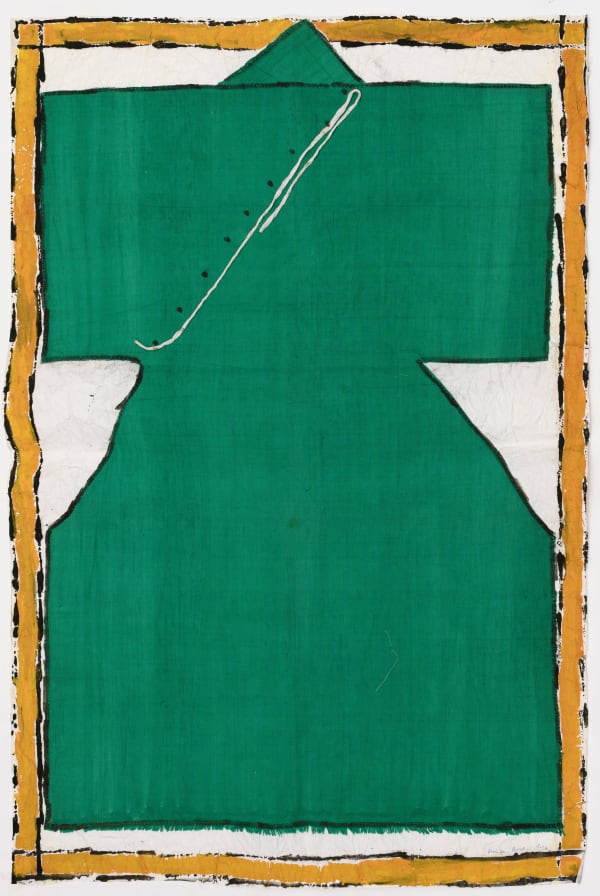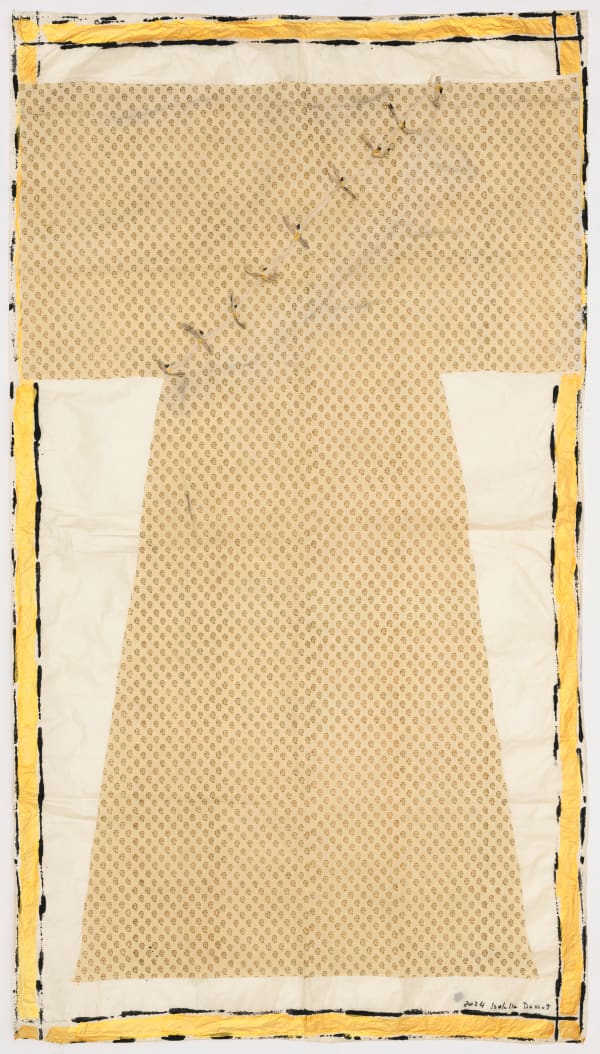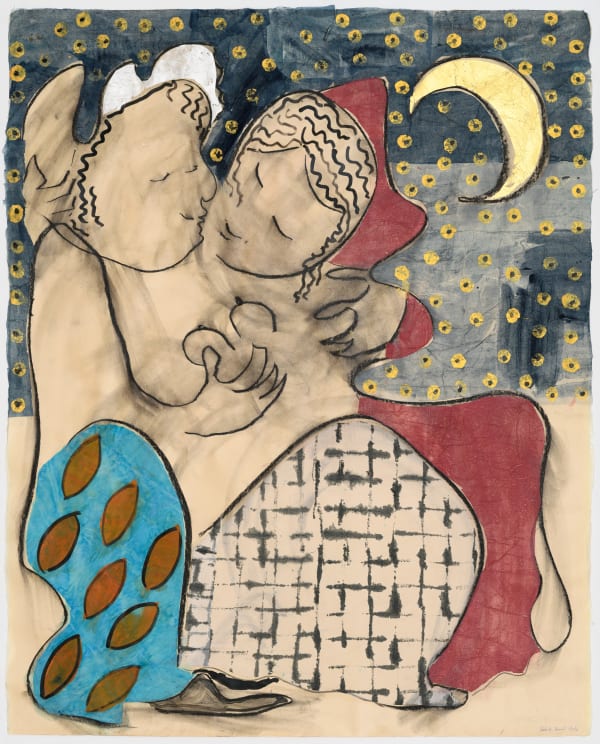2024: Isabella Ducrot
Opening
Thursday, 07.11 at 5 – 7 PM
Θaβros
A little over a year ago Isabella Ducrot’s book “The Checkered Cloth” was gifted to me by Katarina Sjögren at Belenius after I’d given a vivid account of my obsession with vintage checkered shirts that I’ve bought since the late 1980s. Reading that book and writing this text has made me try to understand a little more about the reasons I so love the woven, especially with designs of square patterns in several colors. As with most things I realize there’s no final answer, nor do I think there’s one single reason. In fact, the more I think about it, the less I actually want to solve this, as if it were a riddle. But the fact remains that certain checkered patterns make me feel good just seeing them. Like certain foods create a craving to devour them, the cloths create an urge to envelop my body with them.
It was a delight to read Isabella Ducrot’s reflections on Simone Martini’s altarpiece “The Annunciation with St. Margaret and St. Ansanus” and the checkered cloth lining of the Angel’s mantle, this “secret part of the Angel’s clothing” in the words of Ducrot. Her thoughts are not unlike mine, concerning an enigma that one can chose to leave in mystery. Further into the book Ducrot recalls different checkered textiles and memories associated with them. She asks herself why checkered cloth is almost entirely absent in ancient western painting and after looking into the matter concludes that the history of plaid is connected to women and their worlds which excludes this cloth – and these worlds – from being represented in older art. Once checkered cloths start appearing in art, she reflects, it is to connote the status of those wearing it: people who were rarely depicted in earlier art. Ducrot continues reflecting on the origins of weaving and on its parallel to the development of thought and language, its structure and texture, musicality and poetry. To me, she seems to be saying that weaving is one of the most human of activities. It represents and preserves life itself.
When one is asked to write a text, I often find it tempting to look into a certain subject’s etymology and to trace the history of it. Weaving and fabric are of course ancient human endeavors and materials. One thing I had never thought about is that this history is extremely tightly woven (pardon the pun) to the existence of body lice. Researchers have found that the origin of body lice correlates with the spread of modern humans out of Africa through the origin of clothing, around 70,000 years ago. An assumption is that clothing allowed modern humans to spread into more extreme latitudes. X) These facts led me to stray off to look into the lives of body lice, which is no laughing matter. But I digress.
I mentioned earlier my obsession with vintage checkered shirts, all of which I’ve kept in boxes, neatly folded. Most of them were bought in second hand clothing stores in Germany in which you could buy clothing per kilo. The extremely low prices made it possible to not even try things on, but just buy all shirts with patterns and fabric I liked – all of which were checkered. Often the shirt would not fit at all, but many have also been favorites warn close to obliteration. When it comes to the actual patterns, I strongly prefer woven checkered cloth to printed patterns. The feeling is just so much more intense when you can trace the thread and actually follow the process of weaving. There is something about the act of making that can be read in the fabric which keeps it alive. It’s filled with movement and tension.
Richard Julin, Artistic director of Accelerator at Stockholm University, 2024
Isabella Ducrot (b. 1931) in Naples, Italy. Lives and works in Rome, Italy.
Ducrot is known for her devoted use of woven cloth as the founding material of her paintings. Only beginning her artistic career later in life, the Italian artist has assembled a sublime collection of antique textiles through her extensive travels through Asia, originating primarily from Turkey, India, China, Tibet and Afghanistan.
Ducrot’s solo shows include Le Consortium, Dijon 2024, MAXXI Taormina, 2023, Art Basel Unlimited, Basel 2022, San Giuseppe alle Scalze a Pontecorvo, Napoli 2021, Spazio Parlato, Palermo 2018 and Museo Archeologico Nazionale di Napoli, Naples 2015. In 2024 Galerie Gisela Capitain, Sadio Colew HQ and Standard showed a joint solo presentation at Frieze Masters, London.
In 2014 Ducrot had a major exhibition at the Galleria Nazionale d’Arte Moderna e Contemporanea in Rome and participated at the Venice Biennales in 2011 and 1993. Recent Group exhibitions include Zweigstelle Capitain III – Napoli, Museo Carlo Bilotti Aranciera di Villa Borghese, Rome, Villa Lontana, Rome, both 2021 and Standard (Oslo) 2020, among others. Isabella Ducrot is also the author of numerous publications, including Twenty-Two Places of the Soul 2022, Women’s Life 2021, La stoffa a quadri 2019, and La Matassa Primordiale 2008. Additionally, she participated in the Venice Biennale in 1993 and 2011.
In 2024 Ducrot created the stage and setting for the Dior SS24 Collection at Musée Rodin in Paris, invited by Maria Grazia Chiuri.
Photo credit: Giorgio Benni
-
 Isabella Ducrot, Abito Grande I, 2024
Isabella Ducrot, Abito Grande I, 2024 -
 Isabella Ducrot, Abito Grande II, 2024
Isabella Ducrot, Abito Grande II, 2024 -
 Isabella Ducrot, Camicia da Notte, 2024
Isabella Ducrot, Camicia da Notte, 2024 -
 Isabella Ducrot, Red Dress, 2024
Isabella Ducrot, Red Dress, 2024
-
 Isabella Ducrot, Green Dress, 2024
Isabella Ducrot, Green Dress, 2024 -
 Isabella Ducrot, Checkered Dress I, 2024
Isabella Ducrot, Checkered Dress I, 2024 -
 Isabella Ducrot, Japanise Dress, 2021
Isabella Ducrot, Japanise Dress, 2021 -
 Isabella Ducrot, Checkered Dress II, 2024
Isabella Ducrot, Checkered Dress II, 2024


















